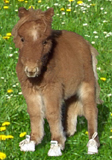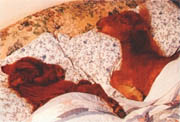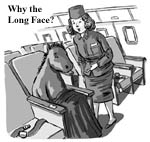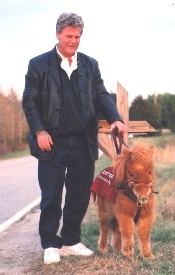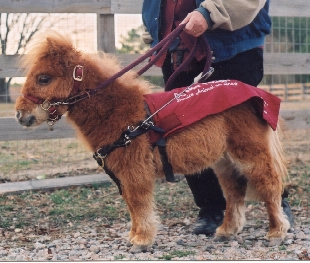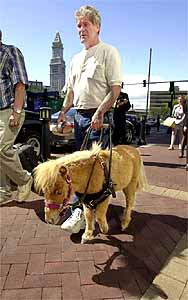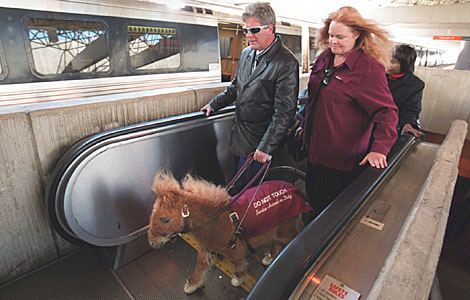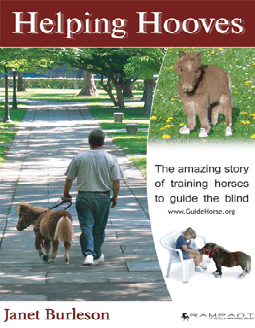|
Her Perfect Pal
By Jeanne Marie Laskas
For the first time in four years, Donna
Grahmann, who is nearly blind, walked around a department store
without the aid of her husband or her mother. Instead, she
shopped with Pal, her horse.
Yes, a horse. At 151 pounds and
2.5-feet tall, Pal, a registered miniature horse and trained
guide, is learning to go everywhere with Grahmann, 43, of
Magnolia, Texas. Pal wears a harness and a blanket that says.
“Do not touch. Assistance animal on duty,” and specially made
sneakers so his hooves don’t skid on slippery surfaces. A side
benefit of the sneakers is that the clip, clop, clip, clop sound
of Pal’s gate is muffles, causing less of a stir among strangers
who aren’t used to seeing a horse, say, trotting by the makeup
counter, or for that matter, wandering through the linen
department. Pal did a great job of warning Grahmann that a pile
of blankets had just fallen into one isle, and led her clear of
them.
Later, Grahmann met her
husband, David, who had been shopping on his own, and they went
outside. It was time to test some of Pal’s 23 verbal commands,
such as: “Okay, Pal. Find the truck!” And so Pal clopped to the
truck and quietly took his place in the back of the extended
cab. He hung his head over the front seat, and Grahmann gave
him a carrot and a scratch. “That’s my buddy,” she said. “Good
boy.”
Pal arrived in Grahmann’s life
on Thanksgiving Day, 2003, and ever since it’s been a learning
experience. Using miniature horses as guide animals is still in
its infancy. Just three have been placed in U.S. homes by the
Guide Horse Foundation of Kittrell, North Carolina, the first
organization to train miniature horses, a breed more known to
make great pet than guide animals.
An animal lover by nature,
Grahmann had considered getting a guide dog when her eyesight
dramatically worsened in the 1990s due to her life long battle
with diabetes. But she was disheartened by the lengthy waiting
list of the program she looked into. There were also her three
border collies. How would they handle a new dog constantly be
her side? She gave up on the idea. Back then, as she lost all
the sight in her right eye and the surgeries on her left reduced
her to small spots of vision, it seemed everything was
impossible.
Indeed, it was as if her whole,
happy life was coming apart.
Horses were her first love. As
a kid, she had asked her mother for a horse every year for
Christmas, and when she turned 17, her wish finally came true.
Grahmann rode Rebel in horse shows for years, winning ribbons
and state championships—and he eventually led her to David, a
contractor whom she met at the barn where the horse was boarded.
When she married David, Rebel came too, moving into a small barn
in the couple’s three-acre backyard. Grahmann continues to ride
in competitions even as her eyesight deteriorated. “Rebel and I
were automatic,” she says. “I trusted him with my life.”
Then, in 1990, she lost Rebel to a single
bolt of lightening while he stood by the barn. It was a
devastating loss for the woman who was already losing so much.
As darkness filled her world in the most literal ways, what she
held onto the memory of Rebel’s eyes. She never found another
horse with “Rebel eyes.”
One day in 2002, her mother was
with her in the waiting room of a doctor’s office. “You’re not
going to believe this,” her mother said, reading a magazine.
“Guide horses?” She read the article to Grahmann. The Guide
Horse Foundation was founded in 1999 by Janet Burleson, a
veteran horse trainer, and her husband, Don. Their inspiration,
in part was their pet miniature horse, Twinkie (she’s the mascot
for the organization, and not in service), who followed them
around like a dog.
Anyone who has ever seen a
police horse navigate city traffic knows that well-trained
horses can be incredibly calm and focused. As herd animals,
horses can form bonds for life, making them ideal service
animals. Horses also have great memories, are vigilant, and can
see 360 degrees and have excellent night vision. Burleson, who
had trained Arabians for 30 years, knew how to teach commands,
and with the help of guide-dog trainers, eventually came up with
a system that worked.
The volunteer-run Guide Horse
Foundation is funded by donation, so the horses are placed free
of charge. Each horse goes through at least six months of
training by Burleson and her team. Guide horses aren’t for
everyone—you need a yard big enough for grazing and a small
shelter—but they’re alternatives for people who are allergic to
or afraid of dogs, and for those who want a guide animals with a
long life span: Miniature horses normally live up to 35 years.
Grahmann went to North Carolina
for a three-week training course on how to work with Pal. He
already knew the verbal commands, but she had to learn how to
handle his harness, how to ride escalators with him, how to
cross the street, and how to know just when he had to go
outside. (Yes, horses can be house-trained)
“Pal has totally changed my
life,” Grahmann says. “I couldn’t go anywhere by myself
before—and—now look at me!” She and her husband are teaching Pal
the layout of the whole mall—they simply take him for walks,
making note of doors and elevators. Once Pal learns its layout,
Grahmann will be free to wander into the food court and into
dressing rooms, just the two of them. He doesn’t help her inside
her home, although it would certainly be possible to train him
to. But Grahmann doesn’t need a lot of help around the house, so
she keep’s Pal in Rebel’s old barn, with a companion horse, also
a miniature. (The foundation insists that the horses have
companions for their mental health, and so they donate them,
too)
Pal has already brought
Grahmann some degree of mobility, such as on that recent day of
shopping in a department store. A small moment, but a real joy
for a woman who for years has been unable to move about without
the assistance of a family member. But her newfound freedom is
about more tan just logistics.
“Pal has Rebel eyes,” she says
with a whisper of longing. “I saw them the first day I met him.”
She saw them through the small spots of vision. She saw them and
fell in love. “I embraced him and loved him and petted him, and
he soaked it all in. He’s become the calming force in my life.”
|
